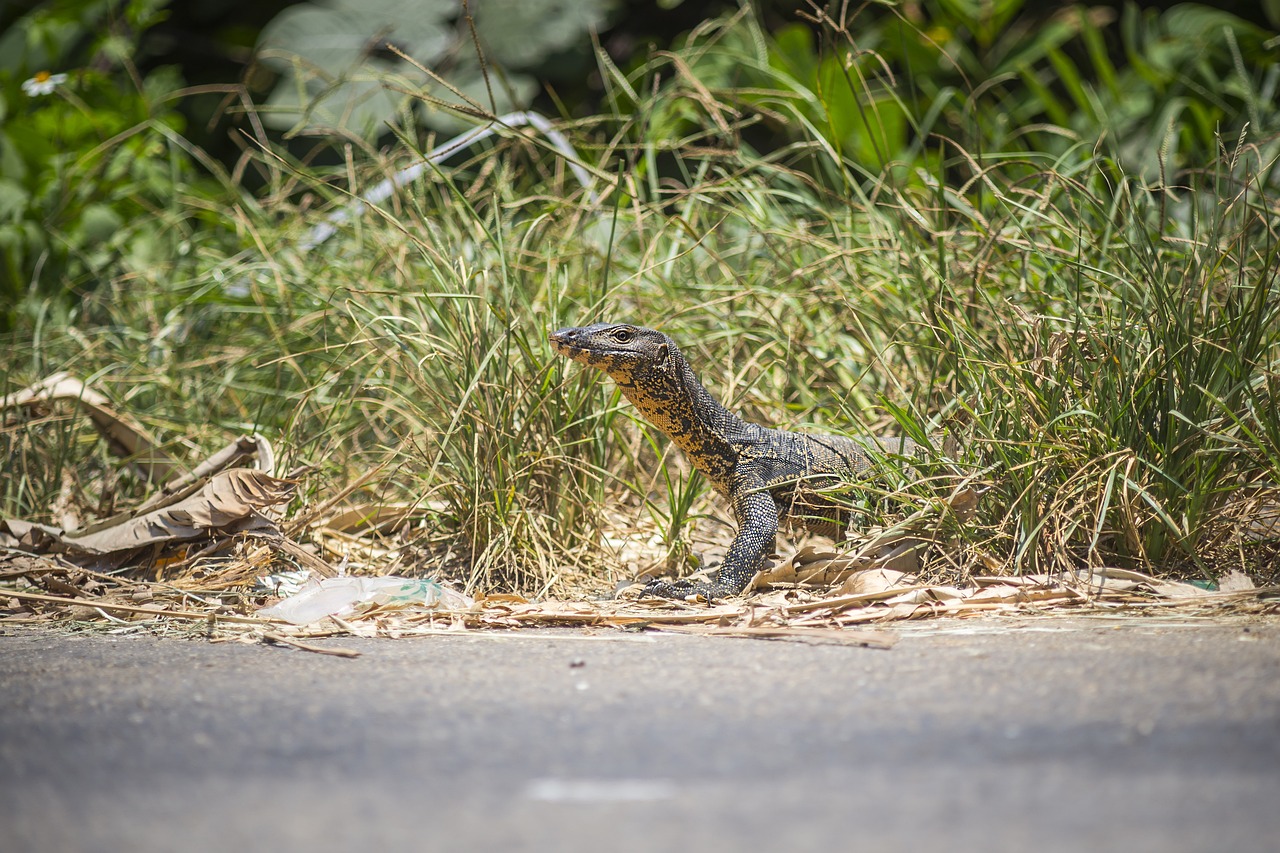The Asian Water Monitor (Varanus salvator) is one of the largest lizard species in the world, belonging to the Varanidae family. This reptile is known for its adaptability, agility, and impressive size, making it a fascinating yet intimidating presence in its natural habitat.
Appearance
- Size: Adult water monitors can reach lengths of up to 3 meters (10 feet), but more commonly range between 1.5 to 2 meters (5 to 7 feet). They can weigh anywhere from 19 to 50 kilograms (42 to 110 pounds).
- Coloration: The skin is generally dark brown to black, with distinctive yellow or golden bands and spots scattered across its body, which may fade with age. Juveniles often have brighter and more prominent patterns compared to adults.
- Physical Features:
- Head: A long, narrow head with a forked tongue, similar to snakes, which it uses to detect scents.
- Body: Streamlined and muscular, ideal for both swimming and running.
- Tail: Long and laterally compressed, aiding in swimming.
- Limbs: Strong, with sharp claws for climbing and digging.
Distribution and Habitat
- Geographical Range: Native to South and Southeast Asia, including India, Sri Lanka, Bangladesh, Myanmar, Thailand, Vietnam, Malaysia, Indonesia, and the Philippines.
- Preferred Habitats: Highly versatile, water monitors are found in a wide range of habitats, including mangroves, swamps, rivers, lakes, marshes, coastal areas, and even urban environments. They are excellent swimmers and are often seen basking on riverbanks or tree branches near water.
Behavior and Diet
- Diet: Water monitors are opportunistic carnivores and scavengers. They feed on a variety of prey, including fish, amphibians, crustaceans, birds, small mammals, insects, eggs, carrion, and even garbage in urban areas.
- Behavior:
- Swimming: They are strong, agile swimmers and can remain submerged for up to 30 minutes. Their laterally flattened tails and muscular bodies make them adept at moving through water.
- Climbing and Digging: They are also good climbers and can scale trees to escape predators or hunt for prey. Their claws are strong enough for digging burrows or foraging for food.
- Territorial: Males are territorial and may engage in combat during the breeding season.
- Communication: They use body language, hissing, and tongue flicking to communicate and sense their environment.
Reproduction
- Breeding Season: Typically occurs during the wet season, although it can vary by region.
- Egg-Laying: Females lay between 10 to 40 eggs in a burrow or under debris. The eggs incubate for around 6 to 8 months before hatching.
- Hatchlings: Young monitors are fully independent at birth, with bright coloration and patterns to help them blend into their surroundings and avoid predators.
Adaptability and Survival
- Habitat Adaptation: Their ability to thrive in diverse habitats, from dense forests to bustling cities, has made them highly successful. They are known to scavenge in urban areas, sometimes leading to conflicts with humans.
- Defense Mechanisms: When threatened, they can hiss loudly, puff up their bodies, lash out with their tails, and use their strong bite as a defense.
Conservation Status
- IUCN Status: Listed as “Least Concern” due to their wide distribution and adaptability, but they face threats from habitat loss, hunting for skin and meat, and the exotic pet trade in some regions.
Importance in the Ecosystem
- Role as Scavengers: Asian Water Monitors play a crucial role as scavengers, helping to keep their environment clean by consuming carrion and controlling populations of smaller animals and pests.
- Ecological Indicator: Being sensitive to environmental changes, their presence and health can indicate the state of their habitat.
Interaction with Humans
- Human Conflict: Water monitors can occasionally become a nuisance in urban areas, scavenging through trash or invading poultry farms. However, they generally avoid human contact unless provoked.
- Cultural Significance: In some cultures, water monitors are considered symbols of luck, while in others, they may be feared or hunted.
The Asian Water Monitor is a remarkable and resilient reptile, known for its adaptability and versatility, playing a vital role in the ecosystems it inhabits.
Visited 843 times, 5 visit(s) today
Views: 1138
Subscribe to the newsletter:
